译者的话:
“眼见他起高楼,眼见他宴宾客,眼见他.....”,咱们今天说的不是楼房养猪,倒是另外一种超级接地气养猪方式--大棚养猪。大棚养猪的优势明显:小快省--单体地块需求小、启动资金相对封闭猪舍更少、猪舍建筑成本低、建设周期很短、功能切换很容易(养猪-不养猪),劣势也同样显著:更多的劳力、垫料&饲料消耗多等。本文详尽地陈述、分析大棚猪舍与封闭猪舍在建筑、运营、维护、效益等方面并进行比对,在生猪养殖模式方面展示了另外的一种可能性,对于有限资本想快速进入生猪养殖行业的投资者,大棚猪舍养殖不失为最佳选择之一,但是否适用与中国或者自己, 视各自掌控的资源而定。大棚猪舍--此地风景颇有奇异之处, 有请观瞻.....
大棚猪舍的建设和管理 (下)
Managing Market Pigs in Hoop Structures (Part 3)
作者 Authors
1Mark S. Honeyman
2Frederick Wm. Koenig
1Jay D. Harmon
1Don C. Lay, Jr.
1James B. Kliebenstein
1Thomas L. Richard
3Michael C. Brumm
1爱荷华州立大学 Iowa State University
2美国中西部计划委员会 MidWest Plan Service
3内布拉斯加大学 University of Nebraska
审稿人 Reviewers
Eldridge R. Collins, Jr.,
弗吉尼亚理工学院和州立大学
Virginia Polytechnic Institute and State University
Don D. Jones
普渡大学 Purdue University
预算和人工问题
Budget and Labor Issues
表4展示了人工、运营和固定成本的范围。此外,胴体质量会影响肉品加工厂的报价。对这些方面的了解可以使生产者对大棚猪舍和其他类型的猪舍进行策略性的比较和选择。封闭式猪舍的固定成本按总投资的13.2%计算,大棚猪舍的固定成本按总投资的16.5%计算。封闭式猪舍的折旧年限为15年(每年6.7%),大棚猪舍的折旧年限为10年(每年10%)。两种体系的假定利率均为10%(初始投资的5%)。垫料成本是每头猪200磅玉米杆。封闭式猪舍和大棚猪舍之间0.2的料重比差异是基于之前的研究和生产者的经验所得。
Table 4 shows cost ranges for labor, operating, and fixed costs. In addition, carcass quality can affect the price offered by a packer. Knowledge of these items will enable producers to strategically compare hoop buildings to other options. Fixed costs are calculated at 13.2% of total investment for confinement and 16.5% for hoops. Confinement facilities are depreciated over 15 years (6.7% annually), while hoops are depreciated over 10 years (10% annually). An interest rate of 10% is assumed for both systems (5% of initial investment). Bedding cost is at the rate of 200 lb of cornstalks per pig. Feed efficiency difference of 0.2 between the hoop and confinement system is based on previous studies and swine producer observations.
表4:估算成本。生长育肥猪大棚猪舍。
Table 4: Estimated costs. Based on Table 4, Hoop Structures for Grow-Finish Swine, AED-41.
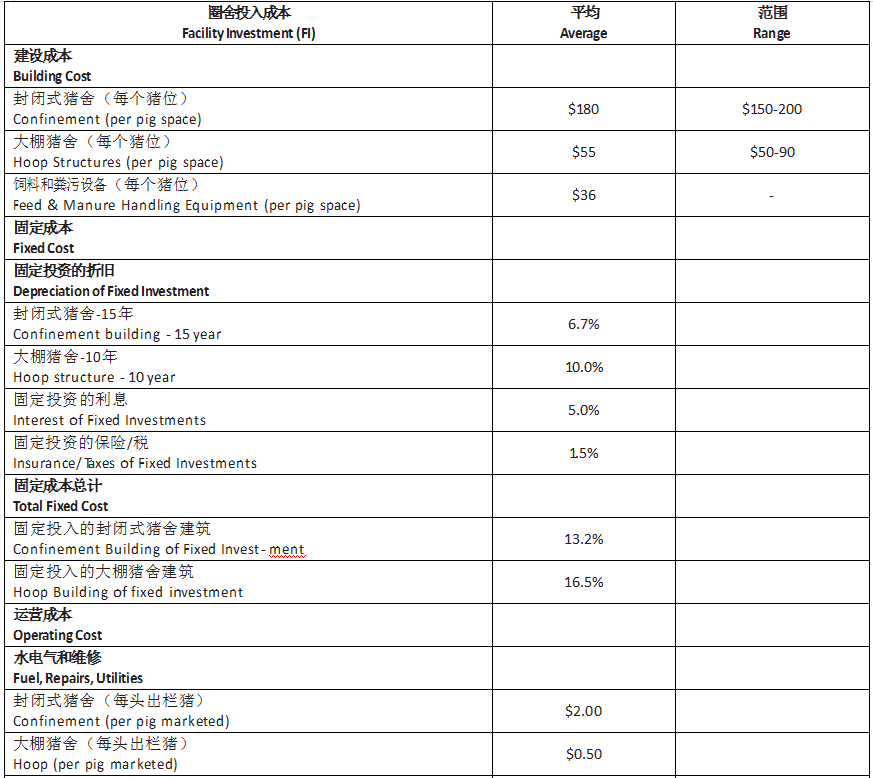
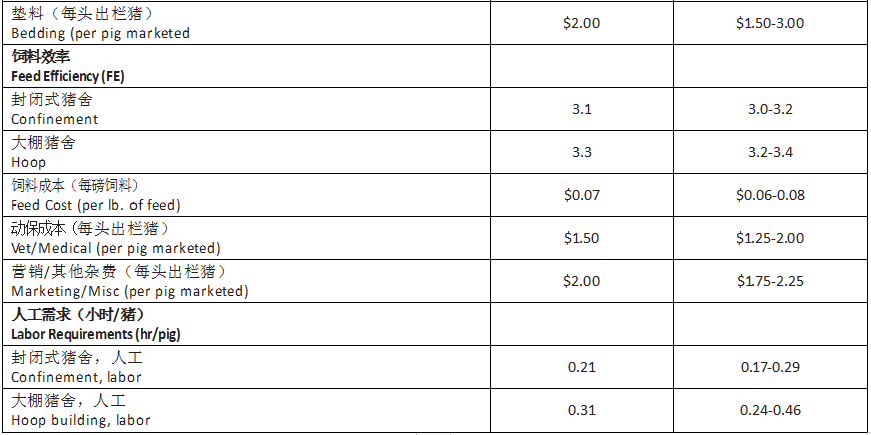
人工需求。对养猪生产体系来说,人工需求是一项高度可变投入。根据猪场的布局、自动化水平、使用时间和设施条件等因素的不同,其所需的人工也是不同的。表4还显示了各项工作的劳动估计量。通常,产生固体粪肥的生产体系被认为比产生液态粪肥的生产体系所需的人工更多。使用机械处理大捆垫料的大棚猪舍所需的人工与传统的养猪体系所需人工量是一样的。大棚猪舍所需的人工量可能比新建的、设计良好的封闭式猪舍所需的人工稍多一些,主要是因为大棚猪舍必须要有成捆的秸秆运输至猪场并放入猪舍中作为垫料。这个差异约为0.1小时每头猪。
Labor requirements. Labor requirements are a highly variable input to swine production systems. Labor varies from farm to farm depending on the layout, level of automation, age and condition of facilities, and other factors. Table 4 also shows some estimated amounts of labor for various tasks. Frequently, production systems with solid manure are viewed as systems that require more labor than production systems with liquid manure. In hoop structures with full-width end access and large bedding bales handled mechanically, the amount of labor required is comparable to the labor needs of conventional systems. Labor needs with hoop structures are probably slightly more than they are in new, well designed confinement systems primarily because large bales of bedding must be hauled and placed into the hooped structure. This difference is estimated at 0.1 hour more per pig.
然而,对大棚猪舍来说,所需的人工类型是完全不同的。这些人工所负责的工作主要包括给猪提供垫料、检查猪群、清理垫草。每天巡栏是至关重要的;对于有深层垫草的大型猪群来说,对猪的持续观察是成功的关键。
The type of labor, however, is quite different for hoop structures. It includes bedding the pigs, checking the pigs, and bedding pack clean out. Walking the bedding area daily to check pigs is crucial; with large groups of deep-bedded pigs, consistent observation of pigs is critical for success.
成本分析。表5展示了封闭式猪舍和大棚猪舍的成本分析比较。成本因所处位置和材料的可获取性而异,所以我们建议您在“自我估算”一栏中做自己的预算,以反映您的运营情况。可以使用表4来帮助估计成本。
Cost analysis. Table 5 shows a cost analysis comparing confinement and hoop buildings. Costs vary depending on location and availability of materials, so you are encouraged to prepare your own budget in the Your Estimate column with values that reflect your operation. Use Table 4 to help estimate your costs.
表5:上市猪成本比较。生长-育肥猪大棚猪舍。
Table 5: Market swine cost comparison. Based on Table 5, Hoop Structures for Grow-Finish Swine, AED-41.
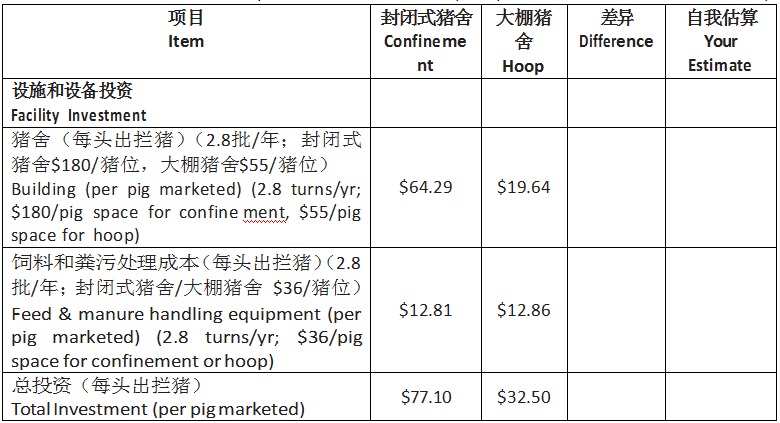
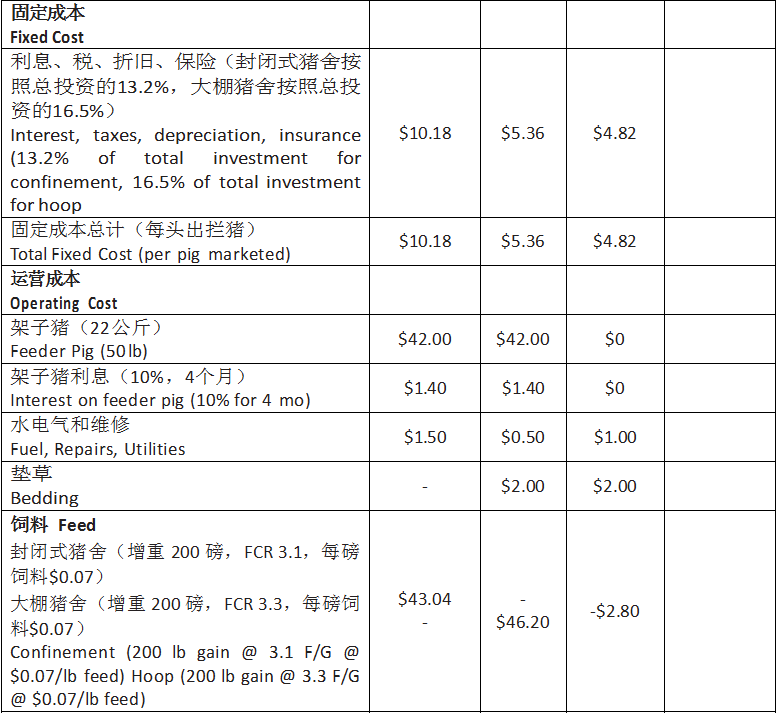
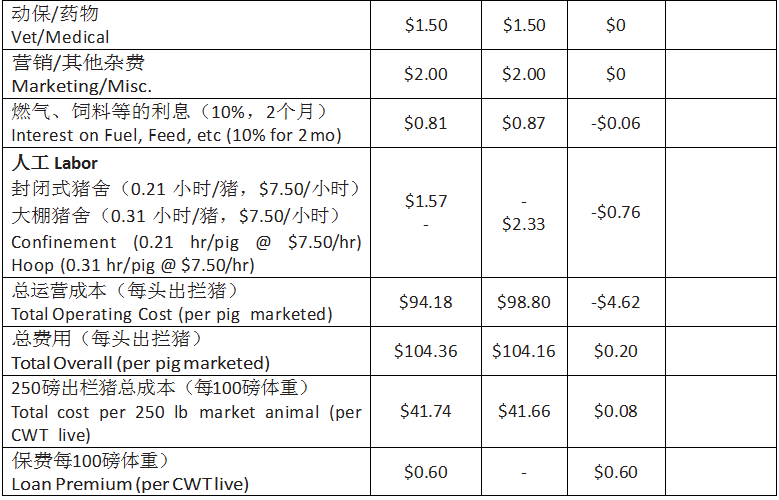

对于每个猪位的建设成本,表5使用了封闭式猪舍每头猪180美元,而大棚猪舍每头猪55美元。两种体系都按照每年生产2.8批猪计算。两种体系的饲料和粪污处理设备的投入是一样的。同样,根据体系设计和所处位置等的不同,这些估计值在您的猪场中可能会有所不同。
The comparisons in Table 5 use a cost of $180 per pig space for a confinement system compared to $55 per pig space for a hoop structure. Each system has 2.8 groups of pigs produced per year. Investment in manure and feed handling equipment is the same for each system. Again, depending upon alterations in system design, location, etc., these values may differ for your operation.
封闭式猪舍的固定成本按总投资的13.2%计算,而大棚猪舍的固定成本按总投资的16.5%计算。两种体系的利率均为10%(平均投资的5%),保险和税为1.5%。
Fixed costs are calculated at 13.2% of investment for a confinement facility and 16.5% for the hooped facility. The interest rate is 10% (5% on average investment), with insurance and taxes at 1.5% for both facility types.
封闭式猪舍的平均使用寿命是15年。由于大棚结构作为养猪圈舍使用还是一种相对较新的做法,目前尚未有完整的预期使用寿命数据;目前最可靠的预测是大棚猪舍的使用寿命为至少10年。
Life expectancy, on average, is 15 years for a confinement building. Because the use of hoop structures as swine housing is a relatively new practice, life expectancy data are not complete; the best estimate is that hoop structures will last at least 10 years.
饲料、修理、垫料等的估算都是基于爱荷华州立大学的数据。垫料的成本是按照每头猪200磅碎玉米秆估算的。每捆1200磅重的秸秆,按照12.00美元每捆计算,成本为每磅1美分。利息按照10%估算,包括4个月架子猪的成本和2个月除人工外其他运营成本的费用。
Feed, repairs, bedding, etc., are based on Iowa State University data. The bedding cost is for the rate of 200 lb of shredded cornstalks per pig. A 1,200 lb bale at $12.00 per bale provides a cost of 1¢ per lb. Interest is at 10%, covering 4 months for the feeder pig and 2 months for the other operating costs excluding labor.
封闭式猪舍的料重比按照每磅增重消耗3.1磅饲料,大棚猪舍的料重比按照每磅增重消耗3.3磅饲料,两者相差0.2。 研究表明,饲料效率的年度差异为0.1磅到0.3磅。猪场所处位置会影响到这些估计值,因为在北方的冬季,饲料效率往往会受到最大的影响。包括清粪在内的人工需求(工作时间),封闭式猪舍估计为每头猪12分钟,大棚猪舍估计为每头猪18分钟。
Feed efficiency is 3.1 lb of feed per pound of gain in confinement and 3.3 lb for the hoop facility; for a difference of 0.2 lb more for the hoop structure. Studies have shown an annual difference of 0.1 lb to 0.3 lb. Location can affect these values, as feed efficiency tends to be affected the most during the winter months in the northern climates. Labor requirements, including manure removal, are assumed to be 12 minutes per pig for confinement and 18 minutes per pig for the hooped structure.
封闭式猪舍中的猪背膘少0.1英寸(2.5毫米)会有1.5美元的瘦肉溢价。也即每100磅体重溢价为0.6美元,一头250磅(113公斤)的猪溢价为1.5美元。
A lean premium of $1.50 per pig is based on less backfat of 0.1 inches for pigs in the confinement system. This would provide a premium of $0.60 per CWT live weight or $1.50 for a 250 lb pig。
其他考虑事项 Other Considerations
对于多样化的、中等规模的生产者,大棚猪舍提供了更多的可能性。这种猪舍是多功能性的,可以用于很多用途,例如,干草、机械设备、谷物的储存。大棚结构可由农场的员工自己建造。它的多功能性、生产灵活性和低资本成本可以降低财务风险。大棚猪舍的工作环境质量一般较好,无液态粪肥,猪舍内自然通风量大。日常臭气更少,粪肥可以储存起来,以便在适当的时候施于农田里。但是,所使用的垫料会增加固体粪肥的量,因此需要一种不同于液态粪肥的管理方式。在恶劣的天气条件下,有的垫料需要保护措施,以便于之后使用。对大棚猪舍来说,低成本和高质量的垫料必须是该类猪舍优先考虑的事项。此外,还不清楚在长期使用过程中,病原体或寄生虫是否会在土壤中积聚。
For diversified, moderate-sized swine producers, hoop structures offer some additional considerations. The structures are versatile and could be used for alternative purposes, for example, hay, machinery, or grain storage. The hoop structures can be constructed with onfarm labor. The versatility, production flexibility, and low capital costs may result in reduced financial risk. The quality of the work environment is generally good, with no liquid manure and a large volume of naturally ventilated air inside the building. Day-to-day odor is less, and manure can be stockpiled for spreading at appropriate times. However, the added bedding increases the volume of solid manure and requires a different type of manure management than liquid manure. Some bedding may need to be protected from adverse weather for use late in the year. Low cost, high quality bedding must be a high priority for the system. Also, it is unclear whether pathogens or parasites will build up in the soil floor over long periods of use.
总结 Summary
需要评估大棚猪舍等新型猪舍的全面影响,以确定其短期和长期的效果。考虑使用大棚猪舍的生产者需要评估每种方案的初始成本和运营成本,还需要收集尽可能多的关于动物在不同类型猪舍中的性能表现的数据信息。生产者必须考虑的主要问题包括但不限于:
The full impact of new swine housing alternatives such as hoop structures needs to be evaluated for short- and long-term effects. Producers considering a hoop structure need to evaluate initial costs and operating costs for each alternative. They also need to gather as much information as possible about animal performance in different types of housing. Among the major issues that a producer must consider are the following:
• 大棚猪舍比全封闭猪舍的固定成本更低,但运营成本更高(例如:垫料,劳动力,饲料使用)。
Hoop structures have lower fixed costs and higher operating costs (for example: bedding, labor, feed usage) than totally enclosed housing.
• 大棚结构用途广泛,如果不用于养猪,也可用于其它用途,如机械设备的储存仓库。
Hoop structures are versatile and can be used for other applications, such as machinery storage, if not used to house pigs.
• 如果10年内需要更换防水油布,那么这个更换成本也需要纳入成本计算。
If the tarp covering needs to be replaced before 10 years, tarp replacement costs must be added to cost calculations.
• 由于大棚猪舍的初始成本较低,生产者可以用较少的投资测试他们养猪生产的能力。
Because hoop structures have a lower initial cost, producers can test their capability in swine production with a smaller investment.
• 想要建设几个大棚结构猪舍的生产者可能会发现,用于保持土壤的农作物残体的量将成为一个限制因素。
Producers who want to erect several hoop structures may find that the volume of crop residue for soil conservation will become a limiting factor.
• 希望改善户外泥土地养殖或简易棚屋养殖环境的生产者其投资机会很低。
Producers who wish to improve their situation with dirt lots or sheds and lots have a low investment opportunity.
表5所示的财务信息表明,对于特定用途而言,大棚猪舍是养猪生产中具有竞争力的替代体系。大棚猪舍养猪与在封闭式猪舍中养猪相比,需要更少的资金、更多的劳动力、垫料和稍微多一点的饲料。生产者应该分析成本,比较可替代的养猪体系。在某些成本类似的情况下,其他的因素可能会使决策偏向大棚猪舍或全封闭式猪舍。个人偏好和对某一种体系的感知优势,可能会影响生产者选择更适合特定情形的猪舍类型。例如,一个想要快速扩张的生产者可能会发现大棚猪舍是最好的选择,而另一个生产者可能会认为全封闭性猪舍更悠久的使用历史和已知的属性特定则更可取。
The financial information presented in Table 5 suggests that for a particular application, a hoop structure is a competitive alternative system for pork production. Raising pigs in a hoop system requires less capital, more labor, bedding, and slightly more feed than raising pigs in a confinement system. Producers should analyze their costs and compare alternatives. Given similar costs, other factors may tip the building decision to a hoop structure or a totally enclosed building. Personal preference and perceived benefits of one style over another may sway a producer to choose the housing type which is more appropriate for a specific situation. For example, a producer who wants to expand quickly may find a hoop structure to be the best alternative, while another producer might conclude that the longer history and known attributes of totally enclosed housing are more appealing.
















